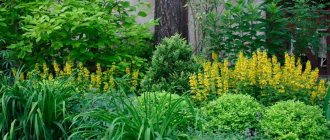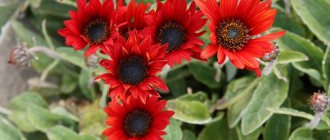Not to be confused with Arecaceae.
Ericaceae family of flowering plants
| Ericaceae | |
| Leptecophylla juniperina | |
| Scientific classification | |
| Kingdom: | Plantae |
| Clade : | Tracheophytes |
| Clade : | Angiosperms |
| Clade : | Eudicots |
| Clade : | Asterids |
| Order: | Ericales |
| Family: | Ericaceae Juss. [1] |
| Type genus | |
| Erika | |
| Subfamilies | |
| |
| Diversity | |
| More than 120 births | |
Ericaceae
are a family of flowering plants, commonly known as
the heather
or
heather
family, found most commonly in acidic and sterile growing conditions.
Large family, s. The 4,250 known species are distributed among 124 genera [2], making it the 14th richest family of flowering plants. [3] Many well-known and economically important members of the Ericaceae family include cranberries, blueberries, huckleberries, rhododendron (including azaleas), and various heathers and heathers ( Erica
,
Cassiope
,
Daboetia
and
Calluna,
for example). [4]
Description[edit]
Ericaceae contain many morphologically diverse taxa, including herbs, dwarf shrubs, shrubs and trees. Their leaves are usually evergreen, [5] alternate or whorled, simple and without stipules. Their flowers are hermaphrodite and highly variable. These petals are often fused (competalous) with shapes ranging from narrowly tubular to funnel-shaped or broadly urn-shaped. The corollas are usually radially symmetrical (actinomorphic) and urn-shaped, but many flowers of the genus Rhododendron
somewhat symmetrical (zygomorphic) on both sides. [6] The anthers open into pores. [7]
Heather family (Ericaceae)
Heathers are a large family, numbering more than 100 genera and over 3,000 species, widely distributed around the globe, not found only in arid regions. Most heathers are shrubs or shrubs, rarely herbs and trees. They grow on acidic soils, but cannot tolerate alkaline soils. There are 6 subfamilies in the family, of which representatives of the subfamily Rhododendroideae (genus Rhododendron) and representatives of the subfamily Cowberry (Vaccinioideae) - genus Vaccinium are considered below. Genus rhododendron
(Rhoaodenaron).
A huge genus, mainly of Himalayan origin, with many evergreen and deciduous species, among which there are beautiful ornamental plants.
Shrubs, less commonly shrubs or small trees. The leaves are simple, elliptic or lanceolate, entire, alternate. The flowers are collected in apical umbellate corymbs or axillary few-flowered racemes. Flowers with double perianth, large, brightly colored, flower formula: ♂♀↑Ca(5)Co(5)A5-∞G(5-10). The fruit is a capsule, the seeds are small and numerous. The flowers have a strong aroma and are pollinated by insects. Rhododendrons form bushes or participate in forest phytocenoses as components of the undergrowth. They are valued for their decorative properties and are widely used in culture. Propagated by summer cuttings. There are about 800 species in the genus, of which up to 15 grow naturally in Russia. Daurian rhododendron
(R. dauricum).
Strongly branched semi-evergreen shrub 1.5-2 (3) m high, with thin brown pubescent shoots. The leaves are small, 2-3 cm long, oval or oval-oblong, with downward-curved edges, leathery, smooth above, scaly below, with a strong aroma. It blooms until leafing, the flowers are numerous, large, violet-pink, 1-3 at the ends of the branches, overwinter in buds. Distributed in Altai, Sayan Mountains, Eastern Siberia and the Far East. Very winter-hardy, found in cultivation up to the Kola Peninsula. Deserves widespread use in landscaping. Blooms in 5-6 years. The fruit is a capsule, opening with 5-10 valves with numerous small seeds. Yellow rhododendron
(R. luteum).
Deciduous shrub 2-3 m high. Shoots with dense glandular-shaggy pubescence. The leaves are oblong, oblanceolate, up to 7.5-10 cm long, narrowed below, pointed at the top, ciliated along the edge. Young leaves are soft fluffy on both sides, later bare. Blooms at the same time as foliage. The flowers are large, up to 5 cm in diameter, yellow, with a strong intoxicating odor in multi-flowered corymbs. The fruit is a cylindrical bare capsule. Naturally grows in the southwestern regions of Russia, in the Caucasus. Winter-hardy, demanding of moisture. Used in landscaping south of St. Petersburg (except for arid areas). In addition to these species, in the Far East, in Eastern Siberia, in the north of Transbaikalia, there are Redovsky rhododendron ( Rh. redowskianum
Maxim) and Schlippenbach rhododendron (
Rh. Schlippenbachii
Maxim), growing on chars, on coarse blocky placers.
Both species are part of the undergrowth. Genus Vaccinium.
It includes about 35 species and is represented by shrubs and shrubs with deciduous or evergreen leaves.
Flowers in racemes or solitary. The calyx fuses with the ovary. Stamens 8-10, free. Ovary inferior, 4-5(10)-locular. The fruit is a berry, fleshy, sour, multi-seeded. There are 7 species in Eastern Siberia and the Far East, and 3 species in Northern Europe. 2n = 24, 48, 72. Useful berry vitamin-rich plants in the northern regions of the country. Common blueberry (V. myrtillus).
Deciduous shrub 15-40 cm high with angular-ribbed branches extending from a creeping stem. Leaves falling. The flower is goblet-shaped, with a nectar disc, pollinated by insects, but possibly also by the wind. The fruit is a spherical black berry with a blue coating, sweet, with a high percentage of sugar (Fig. 37). Processed into jam and syrups. It grows in spruce forests throughout the non-chernozem and partly chernozem strip of European Russia to the Kola Peninsula.
Taxonomy[edit]
Michel Adanson used the term Vaccinia to describe a similar family, but Antoine Laurent de Jussieux was the first to use the term Ericaceae. The name comes from the type genus Erica
, which appears to come from the Greek word
ereike
.
The exact meaning is difficult to interpret, but some sources indicate that it means "heather". The name may have been used informally to refer to plants until the time of Linnaeus, and was simply formalized when Linnaeus described Erica
in 1753, and then again when Jussier described Ericaceae in 1789.[8]
Historically, Ericaceae included both subfamilies and tribes. In 1971, Stevens, who outlined the history since 1876 and in some cases since 1839, recognized six subfamilies (Rhododendroidae, Ericoideae, Vaccinioideae, Pyroloideae, Monotropoideae and Wittsteinioideae) and further divided the four subfamilies into tribes, with Rhododendroidae having seven tribes. (Bejarieae, Rhodoreae, Cladothamneae, Epigaeae, Phyllodoceae and Diplarcheae). [9] Five genera have been described in the tribe Rhodoreae: Rhododendron
L. (including
Azalea
L. pro parte),
Therorhodion
Small,
Ledum
L.,
Tsusiophyllum
Max.,
Menziesia.
J.E. Smith, which were eventually transferred to
Rhododendron
along with Diplarche from the monogenic tribe Diplarcheae. [10]
In 2002, systematic research led to the inclusion of the previously recognized families Empetraceae, Epacridaceae, Monotropaceae, Prionotaceae and Pyrolaceae into Ericaceae based on a combination of molecular, morphological, anatomical and embryological data analyzed within a phylogenetic system. [11] This move greatly increased the morphological and geographic range within the group. One possible classification of the resulting family includes 9 subfamilies, 126 genera and about 4000 species: [3]
- Enkianthoideae Kron, Judd & Anderberg (one genus, 16 species)
- Wintergreen Kosteltsky (4 genera, 40 species)
- Monotropoideae Arnott (10 genera, 15 species)
- Arbutoideae Niedenzu (up to six genera, about 80 species)
- Cassiopoideae Kron & Judd (one genus, 12 species)
- Ericoideae Link (19 genera, 1790 species)
- Harrimanelloideae Kron & Judd (one species)
- Styphelioideae Sweet (35 genera, 545 species)
- Vaccinioideae Arnott (50 genera, 1580 species)
Genera [edit]
See List of Ericaceae genera for a complete list.
Group II - less promising species
It includes 8 genera, 20 species. This is a transitional team. The species here are heterogeneous in their resistance.
There are, for example, winter-hardy species here, but due to their young age have not yet entered the generative phase - these are Empetrum nigrum L., Loiseleuria procumbens (L.) Desv., Leucothoe axillaris (Lam.) D.Don, Rhododendron oreodoxa Franch ., Rhododendron aureum Georgi, Rhododendron makino Tagg ex Nakai., Rhododendron insigne Hemsl. et EH Wils, Rhododendron metternichii Siebold et Zucc., Rhododendron wardii WW Sm.
There are winter-hardy species that died for random reasons; they require reintroduction, for example, Bryanthus musciformis (Poir.) Nakai., Rhododendron williamsianum Rehder et EH Wilson.
Elliottia bracteata
Eubotrys racemosa Nutt is also included in this group - although it is quite old (12 years) and has good winter hardiness, it has not yet entered the generative phase, so the status of this species is still uncertain.
It is difficult to say anything about Oxydendrum arboreum (L.) DC. In its homeland in the USA, this tree is from 4 to 25 m tall, and it is unlikely that it will appear before us in all its beauty. We've had it in our collection for 6 years, and it freezes a lot in unfavorable winters. One can only hope that it will remain in a bushy form and at least delight with the magnificent scarlet-red color of the leaves in the fall.
This group also includes species that in normal years do not freeze, bloom and bear fruit, but suffer during critically cold winters, some die of flower buds, others die of perennial shoots, so they bloom and bear fruit irregularly, only after warm winters. These are types such as
- Leucothoe grayana Maxim,
- Rhododendron campanulatum D. Don,
- Rhododendron degronianum Carr.,
- Rhododendron occidentale (Torr. et A. Gray) A. Gray,
- Rhododendron pachytrichum Franch.,
- Vaccinium arctostaphylos L.,
- Vaccinium deliciosum Piper.,
- Vaccinium macrocarpon Ait.
Rhododendron degronianum ssp degronianum
At the same time, most species develop normally, maintaining their natural growth form. For example, Rhododendron pachytrichum has reached a height of 2 m in our country. Others are losing it, for example, Leucothoe grayana has a very dense, almost cushion-shaped bush with a height of 0.4 m, which was probably facilitated by frequent frost damage in its youth.
It is difficult to judge the decorative value of these species due to their unstable winter hardiness and irregular flowering. Perhaps some of them will be more stable over time, with special hope for their reproduction.
Distribution and ecology[edit]
Heathers have an almost worldwide distribution. They are absent from continental Antarctica, parts of the high Arctic, central Greenland, northern and central Australia, and much of the lowland tropics and neotropics. [3]
The family mainly consists of plants that can tolerate acidic, sterile conditions. Like other stress-tolerant plants, many Ericaceae have mycorrhizal fungi to help extract nutrients from infertile soils, as well as evergreen foliage to preserve absorbed nutrients. [12] This character is not present in Clethraceae and Cyrillaceae, the two families most closely related to Ericaceae. Most Ericaceae (except Monotropoideae and some Styphelioideae) form a characteristic cluster of mycorrhizae, in which fungi grow in and around the roots and provide nutrients to the plant. [13] Wintergreens are mixotrophic and obtain sugars from mycorrhizae as well as nutrients. [14]
In many parts of the world, "heathland" or "heathland" is an environment characterized by an open community of dwarf shrubs found in low-quality acidic soils that are typically dominated by heather plants. A typical example is Erica Tetralix
.
This plant of the family is also characteristic of peat bogs and offset bogs; examples include Rhododendron groenlandicum
and
Kalmia polifolia
. In eastern North America, members of this family often grow under the canopy of oak trees in a habitat known as oak barren forest. [15]
In heathland, plants of the family Ericaceae serve as host plants for the butterfly Plebejus argus
[16]
.
Some evidence suggests that eutrophic rainwater can transform ericoid heaths with species such as Erica tetralix,
to the meadows. [17] Nitrogen is particularly suspect in this regard and can cause marked changes in the distribution and abundance of some Ericaceae species.
Group I – the most promising species
The group includes 13 genera, 41 species. These species are quite winter-hardy. Most of them, even in unfavorable winters, are not damaged or damaged slightly; they bloom profusely almost every year, many bear fruit and have full seed reproduction. All species retained their natural growth form.
Many species of this group have reached a very respectable age in our culture: Albrecht's rhododendron (Rhododendron albrechtii) - 35 years, highbush blueberry (Vaccinium corymbosum) - 34 years, redberry (Vaccinium praestans) - 30 years, etc.
Albrecht's rhododendron (Rhododendron albrechtii)
|
|
|
|
The decorative properties of the species in this group vary. There are many beautifully flowering species here, for example: Kalmia angustifolia, Pieris floribunda, common heather (Calluna vulgaris), Lyonia ligustrina, species of the genus Erica (Erica L.), wild rosemary (Ledum L.) , rhododendron (Rhododendron L.).
|
|
Ledum palustre
Representatives of the genus Leucothoe (Leucothoe D.Don) stand out for their beautiful evergreen foliage (their flowers are located under the leaves), species of the genus Wintergreen (Gaultheria) are attractive for their unusual fruits.
|
|
|
|
Some species, for example Menziesia ferruginea and Menziesia pilosa, have small, inconspicuous flowers, bloom sparingly and are not very decorative. Unfortunately, many of our local species, for example: Vaccinium myrtillus, V. palustre, V. uliginosum, V. vitis-idaea, also do not have abundant flowering and fruiting and are much inferior in decorativeness and productivity to foreign species: V. angustifolium, V. corymbosum, V. praestans. In this group:
- Polyfolia (Andromeda polifolia L.) and its varieties
- Common heather (Calluna vulgaris (L.) Hull) and its varieties
- Bog myrtle (Chamaedaphne calyculata (L.) Moench)
- Erica herbacea L. and its varieties and forms
- Erica × darleyensis Bean
- Erica spiculifolia Salisb.
- Erica tetralix L.
- Erica vagans L.
- Wintergreen (Gaultheria cuneata (Rehd et Wils) Bean)
- Wintergreen Mikel (Gaultheria pyroloides Hook. f. et Thoms. ex Miq.)
- Wintergreen (Gaultheria procumbens L.)
- Kalmia angustifolia L.
- Ledum columbianum Piper
- Ledum glandulosum Nutt.
- Large-leaved wild rosemary (Ledum macrophyllum Tolm.)
- Ledum palustre L.
- Greenland Ledum (Ledum palustre ssp. groenlandicum (Oeder) Hultén)
- Leucothoe catesbaei (Walt) Gray
- Leucothoe fontanesiana (Steud.) Sleum.
- Walter's leukotoe (L. walteri (Willd.) Melvin.)
- Lyonia ligustrina (L.) DC.
- Mencisia ferruginea Sm.
- Hairy mencisia (Menziesia pilosa (Michx.) Juss.)
- Pieris floribunda (Pursh) Benth. et Hook.f.
- Albrecht's rhododendron (Rhododendron albrechtii Maxim.)
- Atlantic rhododendron (Rhododendron atlanticum (Ashe) Rehd.)
- Kamchatka rhododendron (Rhododendron camtschaticum Pall.)
- Caucasian rhododendron (Rhododendron caucasicum Pall.)
- Rhododendron fastigiatum Franch.
- Rusty rhododendron (Rhododendron ferrugineum L.)
- Rhododendron hirsutum L.
- Ungern's rhododendron (Rhododendron ungernii Trautv. ex Regel)
- Blueberry (Vaccinium angustifolium Ait.)
- Blueberry (Vaccinium atrococcum (Grey) Heller)
- Blueberry (Vaccinium corymbosum L.)
- Blueberries (Vaccinium myrtillus L.)
- Swamp cranberry (Vaccinium palustre Salisb.)
- Krasnika, or bed bug (Vaccinium praestans Lamb.)
- Blueberry (Vaccinium uliginosum L.)
- Lingonberry (Vaccinium vitis-idaea L.) and its varieties.
Kamchatka rhododendron (Rhododendron camtschaticum)
|
|
Links[edit]
- Group III of the Angiosperm Phylogeny (2009). "An updated classification of the angiosperm phylogenetic group for orders and families of flowering plants: APG III". Botanical Journal of the Linnean Society
.
161
(2):105–121. DOI: 10.1111/j.1095-8339.2009.00996.x. - Christenhusz, M. J. M., & Bing, J. W. (2016). "Number of known plant species in the world and its annual increase". Phytotax
.
261
(3):201–217. DOI: 10.11646/phytotaxa.261.3.1. - ^ abc Stevens, P. F. (since 2001). "Heathers". Angiosperm Phylogeny Website
. Retrieved December 29, 2014. - Krohn, Kathleen A.; Powell, E. Ann & Luthein, J. L. (2002). "Phylogenetic relationships within the blueberry tribe (Vaccinieae, Ericaceae) based on sequence data from MATK and nuclear ribosomal ITS regions, with comments on the placement of Satyria
."
American Journal of Botany
.
89
(2):327–336. DOI: 10.3732/ajb.89.2.327. PMID 21669741. - Jump up
↑ Patterson, Patricia A. (1985).
A Field Guide to Forest Plants of Northern Idaho
. USDA Forest Service. pp. 37–47. - Watson, L. & Dallwitz, M. J. (August 19, 2014). "Ericaceae Juss". Families of Flowering Plants: Descriptions, Illustrations, Identification, Information Retrieval
. Retrieved December 30, 2014. - "Flowering Plant Families, UH Botany".
- ↑
Jussieu, A.-L.
de (1789). Genera plantarum ordines naturales disposita
. Paris: Herissant & Barrois. pp. 159–160. - Stevens (1971).
- Jump up
↑ Craven, LA (April 2011).
"Diplarche and Menziesia transferred to Rhododendron (Ericaceae)". Blumea
.
56
(1): 33–35. DOI: 10.3767/000651911X568594. - Krohn, K.A.; Judd, W. S.; Stevens, P.F.; Crane, D.M.; Anderberg, A.A.; Gadek, Pennsylvania; Quinn, C. J., & Luteyn, J. L. (2002). "Phylogenetic classification of Ericaceae: molecular and morphological evidence". Botanical Review
.
68
(3):335–423. DOI: 10.1663/0006-8101(2002)068[0335:pcoema]2.0.co; 2. - Keddie, P. A. (2007). Plants and Vegetation: Origins, Processes, Consequences
. Cambridge University Press. - Cairney, J. W. G.; Meharg, A. A. (2003). "Ericoid mycorrhiza: a partnership exploiting harsh edaphic conditions." European Journal of Soil Science
.
54
(4):735–740. DOI: 10.1046/j.1351-0754.2003.0555.x. - Liu, Z.; Wang, Z.; Zhou, J., & Peng, H. (2010). "Phylogeny of Pyroleae (Ericaceae): Implications for character evolution". Journal of Plant Research
.
124
(3):325–337. DOI: 10.1007/s10265-010-0376-8. PMID 20862511. S2CID 38665814. - "Natural Communities of Virginia Classification of Ecological Community Groups (Version 2.6)". Virginia Department of Conservation and Recreation. July 2013 . Retrieved December 30, 2014.
- ↑
Thomas, CD (August 1, 1985).
"Specializations and polyphagy of Plebejus argus (Lepidoptera: Lycaenidae) in North Wales". Ecological entomology
.
10
(3): 325–340. DOI: 10.1111/j.1365-2311.1985.tb00729.x. ISSN 1365-2311. S2CID 86813755. - Keddie, P. A. (2010). Wetland ecology: principles and conservation
(2nd edition). Cambridge University Press. pp. 103–104.
Bibliography[edit]
- Stevens, P. F. (1971). "Classification of Ericaceae: subfamilies and tribes." Botanical Journal of the Linnean Society
.
64
(1): 1–53. DOI: 10.1111/j.1095-8339.1971.tb02133.x. - Cafferty, Steve; Jarvis, Charles E. (November 2002). "Typification of Linnaean plant names in Ericaceae". Taxon
.
51
(4):751–753. DOI: 10.2307/1555030. JSTOR 1555030. - Stevens, P.F.; Luteyn, J.; Oliver, E.G.H.; Bell, T. L.; Brown, E. A.; Crowden, R.K.; George, A.S.; Jordan, G. J.; Ladd, P.; Lemson, K.; McLean, C.B.; Menadue, Y.; Pate, J. S.; Stace, H. M.; Weiller, C. M. (2004). "Heather". In Kubicki, K. (ed.). Flowering plants.
Dicotyledons: Celastrales, Oxalidales, Rosales, Cornales, Ericales .
Families and genera of vascular plants. 6
. Springer. pp. 145–194. ISBN 9783540065128.
External links [edit]
| Wikimedia Commons has media related to Ericaceae . |
| Wikispecies has information about Ericaceae . |
- Ericaceae in the list of plants
- Ericaceae, Epacridaceae, Empetraceae, Monotropaceae and Pyrolaceae in flowering plant families (DELTA)
- Ericaceae at the Encyclopedia of Life
- Ericaceae on the Phylogeny Angiosperm website
- Ericaceae in the Online Flora of North America
- Ericaceae in the online flora of China
- Ericaceae in the online flora of Pakistan
- Ericaceae in the online flora of Chile
- Epacridaceae in New Zealand Flora Online
- Epacridaceae in the Online Flora of Western Australia
- Ericaceae at Ericaceae.org
- Highland, BPM; Whiffin, T.; Zich, F. A.; and others. (December 2010). "Fact Sheet - Ericaceae". Plants of the Australian Rainforest
(6.1, online RFK 6.1 ed.). Cairns, Australia: Commonwealth Scientific and Industrial Research Organization (CSIRO) through its Crop Sciences Division; Australian National Biodiversity Research Centre; Australian Tropical Herbarium, James Cook University. Retrieved May 14, 2013. - Neotropical blueberries at the New York Botanical Garden
| Taxon identifiers |
|











